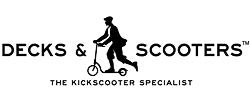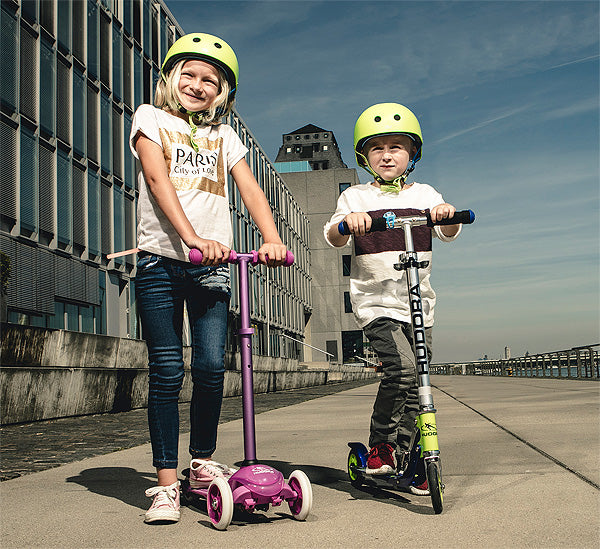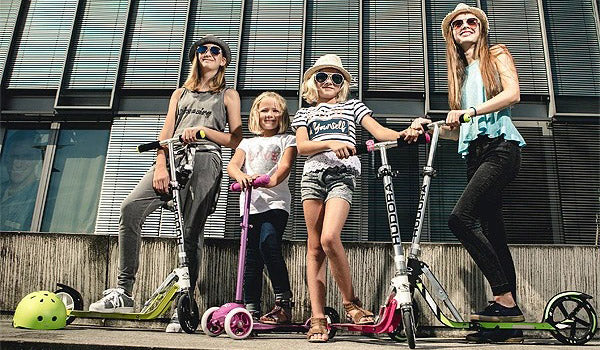
How to choose a kick scooter for children
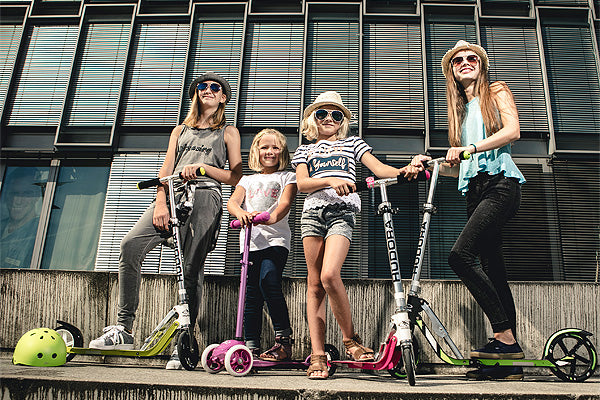
Choosing a kick scooter for a child is more complicated than choosing a kick scooter for an adult. There are more things to consider.
This article answers the following questions
- Which kick scooter is suitable for my kid?
- What is a suitable age for a child to start riding a kick scooter?
- Which kind of kick scooter is suitable for which ages for kids?
- Should I choose a kick scooter with three wheels or two wheels?
- Should I get a small wheeled or a large wheeled kick scooter for my child?
The Purpose of a Kick Scooter for a child
Most parents agree these are the main reasons for buying a kick scooter for their child:
- To build the child's physical confidence and to develop motor skills
- As an additional option for outdoor activity and exercise
- As a preparation for learning to ride a bicycle (with a two-wheel scooter)
- For family outdoor fun!
These reasons will influence the choices made when choosing a kick scooter.
We have distilled the many questions and concerns from our customers who are parents buying a kick scooter for their children into the following points.

Key decisions to be made
A parent usually goes through the following decisions in the buying process:
-
Is my child ready to ride a kick scooter?
-
Should I buy a two-wheeled or three-wheeled kick scooter
-
Should I buy a kick scooter with small wheels or large wheels (usually pertaining to two-wheeled scooters)
Key considerations
The decisions above are affected by these following considerations:
-
the physical size of the child (this is a more practical consideration than the age of the child)
-
the overall motor skill (or physical ability) of the child
- whether the child already knows how to ride a bicycle or a kick scooter
DECISION 1: Is my child ready to ride a kick scooter?
Children differ in motor skills at any given age. So physical ability is a better predictor than age or physical size to determine if a child is ready. Generally, any child who can walk with a steady gait will be able to ride a kick scooter. That means they can usually start from 2 years old.
As any sports coach will tell you, it is generally an advantage to start any given sport as early as physically possible.
If your child is 7 years or older and still can't ride a kick scooter (or bicycle), they are probably slightly behind the curve in motor skill development. Remember that it is possible for many children to successfully ice skate or inline-skate from as 5 years or younger. Riding a kick scooter requires much less motor skill.
In short, most children older than 2 can usually start riding a kick scooter. Of course, a younger/smaller child will probably need to start on a kick scooter that is easier to handle compared to an older/larger child, but more on that later.
Above: it's all about the child's physical ability, not age or body size.
DECISION 2: Should I get a 2-wheeled or 3-wheeled kick scooter
Beyond physical ability, this is the decision with the largest impact on whether the child can safely or successfully ride a kick scooter.
First, lets define what a three-wheel scooter is. There are 4 types
-
Two front wheel, one rear wheel, with lean-to-turn type steering

This is the most common type of three-wheel kick scooter, and will be the primary type of three-wheeled scooter for in this discussion.
This type of kick scooter is easier for very young riders like toddlers to ride because the scooter does half the work of balancing. When going forward, the scooter is self-balanced. When turning, as the description suggests, the rider leans in the direction of the turn in order to steer the scooter. If you still have trouble visualizing how lean-to-steer works, see this video.
To quickly identify whether a three-wheeled kick scooter is a lean-to-steer type, try to turn the handle bars in the same way you would on a bicycle. They do not turn. But tilt the handle bar laterally (with all the scooter wheels in contact with the ground) and you will see the front two wheels will rotate to steer the scooter.
This riding style helps toddlers to quickly and intuitively understand the dynamics between the position of the rider's centre-of-mass and the speed of the turn. It also builds the rider's confidence to lean off-centre, knowing that they can recover. This confidence makes it easier for them learn riding a 2-wheeled scooter or bicycle later on.
Choose this type if your child is around 2 to 5 years old, and are struggling with a two wheel kick scooter. Most of the three-wheeled scooters sold in the market for children belong to this type.
See our collection of 3-wheeled kick scooters. -
Two front wheel, one rear wheel, with bicycle type steering
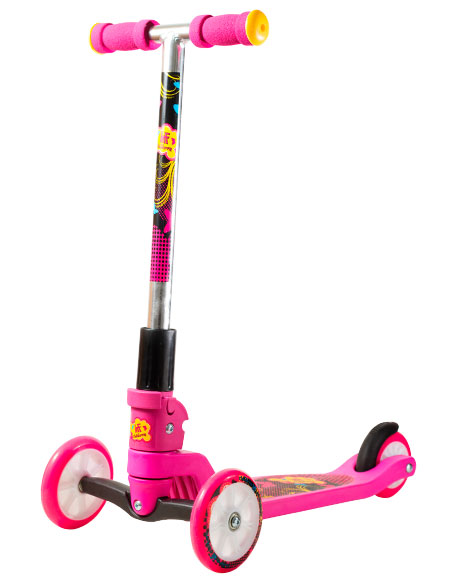
Just like a tricycle but front-to-back. This kind of kick scooter require no balancing skill to ride. This makes them perfect as a first kick scooter for say, a two year old toddler. The flip side? There's practically no benefit in terms of improving balancing motor skill for riding this type of kick scooter. But pushing it around still does work the leg and calf muscles.
This type of scooter is very easy for tiny toddlers. They don't do much to develop balance but gives the kid something fun to push around. Choose this type if you just want your child to get started easily, or if they struggle with a lean-to-steer type.
-
One front wheel, two rear wheels, with bicycle type steering

Effectively a kick scooter version of a tricycle. Ergonomically, they are inferior to the former because the wider wheel base is at the rear, rather than the front of the scooter where most of the body weight is. Also, the rear wheels stick out sideways from the deck and can be struck by the child's heel when pushing.
Like type 3 above, this design does little to develop balance, but they are easier to ride for a very young toddler. Choose this type if your child struggles with the lean-to-steer type. - One front wheel, two rear wheels in a V-shape arrangement (when viewed from top)
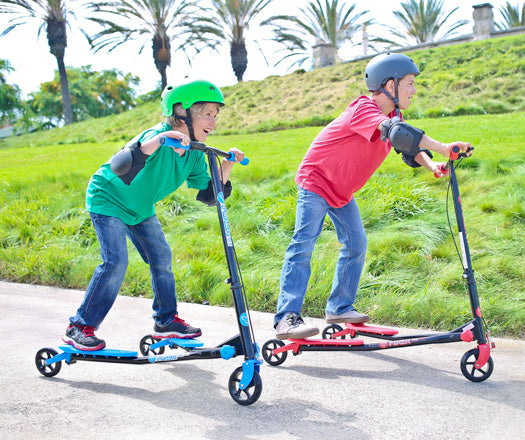
Above: The Yvolution Fliker scooter. Image: yvolution.com
This is a special type of scooter which is propelled forward not by pushing with the feet, but with a hip twisting motion which carves the scooter along. As this type is a designed for a specific way of riding, we will not discuss it in detail here.
Most three-wheeled scooters with a plastic body can carry a rider of up to 35 to 50Kg. There are some aluminum bodied 3 wheel scooters which can carry up to 100Kg and can be ridden by both adults and children.
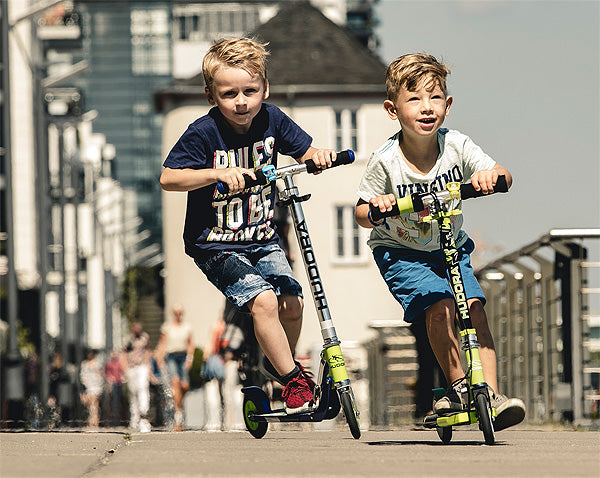
Two-wheeled scooters are require more balancing skill compared to three-wheeled scooters. Like bicycles, they require a certain minimum speed to remain balanced. Also, when turning, all two-wheel scooters require the rider to lean toward the centre of the turn to provide the centripetal force to stay on the curve.
See our collection of two-wheel kick scooters suitable for very young children.
Just like when learning to ride a bicycle, very small children need to overcome two challenges to successfully ride a two-wheeled scooter:
- Challenge 1: getting minimum speed: they must be strong enough push the scooter up to the minimum speed to remain balanced upright, and have enough stamina to maintain that speed.
- Challenge 2: continuous steering: they need to know how to actively and continuously steer the handle bar to maintain control.
Three-wheeled kick scooters remove Challenge 1, since they can remain balanced even when stationary. This allows the child to work on Challenge 2. In time, the child will also learn how to ride pretty fast (as many parents who have to chase after them will know). By that time, Challenge 1 will be easier to overcome.
Here is how the types of scooter rank in terms of how easy they are to ride for a child:
-
3 Wheeled bicycle-steering type (easiest)
-
3-Wheeled lean-to-turn type
- 2-Wheeled type (hardest)
Decision Summary
Consider the following to decide if your child should choose a two-wheeled or three-wheeled kick scooter:
If is easier for a child to start with a three-wheeled scooter if one or more of the following is true:
- if it's the child's first kick scooter
- if the child has not yet learnt to ride a bicycle
- the child is not physically active
- if the child is very young (2 to 5 years)
A child has a good chance of successfully riding a two wheeled scooter if one or more of the following is true:
- the child is physically active
- if the child already knows how to ride a bicycle
- if the child is already successfully riding a three-wheeled scooter
- if the child is tenacious (does not give up easily when unsuccessful)
For two-wheeled kick scooters, read on for more details about choosing a suitable size.
Decision 3: Should I choose a large kick scooter or a small kick scooter for my child?
![]()
This decision is affected by the child's body size and physical ability. Let's first understand the difference between small and large kick scooters.
The overall size of a kick scooter is usually directly related to its wheel size. These are the common kick scooter wheel sizes in the market, and what we usually refer to as small or large:
-
small: 100mm, 120mm, 125mm
-
medium: 145mm, 180mm
-
large: 200mm, 205mm
-
very large: 230mm
Above: some common kick scooter wheel sizes.
Small wheeled scooters
Contrary to popular belief, not all small-wheeled kick scooters are meant for kids. Most if not all aluminum kick scooters can carry a rider of up to 100Kg, regardless of size. The only reason stopping an adult from riding a small wheeled kick scooter is if the handle bar so short that it causes the adult to stoop.
A small deck size is not deal-breaker because we really only need space for a single foot to actually ride a kick scooter (the other foot is pushing most of the time). See our post on how to ride a kick scooter. Many small wheeled kick scooters actually have full height handlebars (about 1m from the ground when fully extended) which allow adults to ride them. In fact, small-wheeled kick scooters are very practical as commuting tools because they are very portable.
Small wheeled kick scooters are very much lighter than large wheel scooters. They can be as much as half the size or weight of a full-sized kick scooter. This make small-wheeled kick scooters easier to ride, handle, steer and accelerate for children. They are also more agile. The downside is that small scooters can be ridden in a relatively more risky, ride-fast, brake-hard style of riding for kids with an aggressive riding style.
Large wheeled scooters
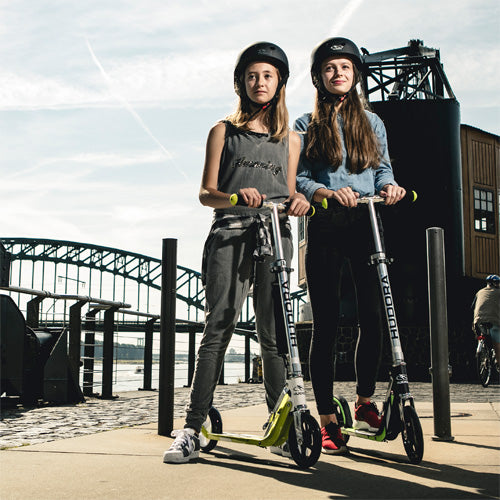
Large wheel kick scooters take more effort to push and steer, and take longer to brake to a stop. So they are more challenging for very small children to ride. However, large wheeled scooters are relatively more stable because of their longer wheel base and perform better over rough surfaces. Their relatively larger bulk and handling effort has a side effect of forcing kids to ride in a more moderated manner.
Large scooters also have the added advantage of a long usable life because the child will be less likely to outgrow it. An adult can also share the scooter with the child.
Scooter size safety consideration
The child's ability aside, it is generally safer for a child to ride a kick scooter which handle bars are lower than the child's neck. If the handle bar is in front of the child's face or neck, there is an increased chance of the handle bar causing injury to the face or neck during a collision. If your child is riding a kick scooter with a height-adjustable handle bar, keep the handle bars below neck height as a precaution. A good guide for the handlebar height is around the height of the stomach to elbow. This applies to both kids and adults.
Final Word
If a test ride is possible, observe your child as they test ride kick scooters of different sizes to see which ones they can handle more effectively. Be sure to ask for their opinion. After all this, your decision will lie somewhere between your willingness to allow your child to take risks and your desire for your child to fully develop his or her motor skills. If in doubt, choose the smaller scooter because they are generally easier to handle, and accept that you may need to buy a larger one later on. Which ever way you choose, remember a kick scooter is supposed to be fun, so don't fret too much over it. []
See our collection of kick scooters for children
Spot a mistake, have an opinion or question about this article? We'd love to hear from you. Contact Us!
